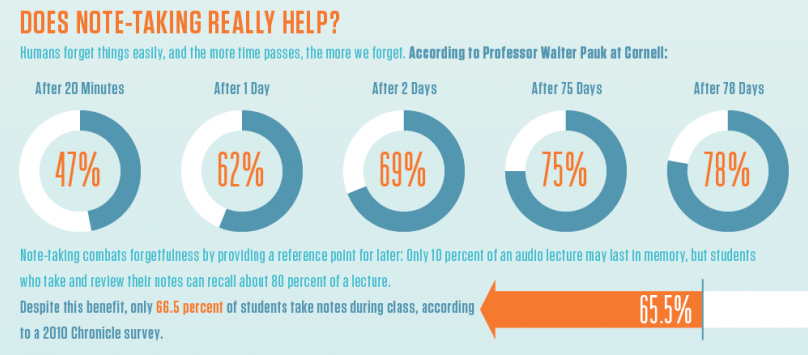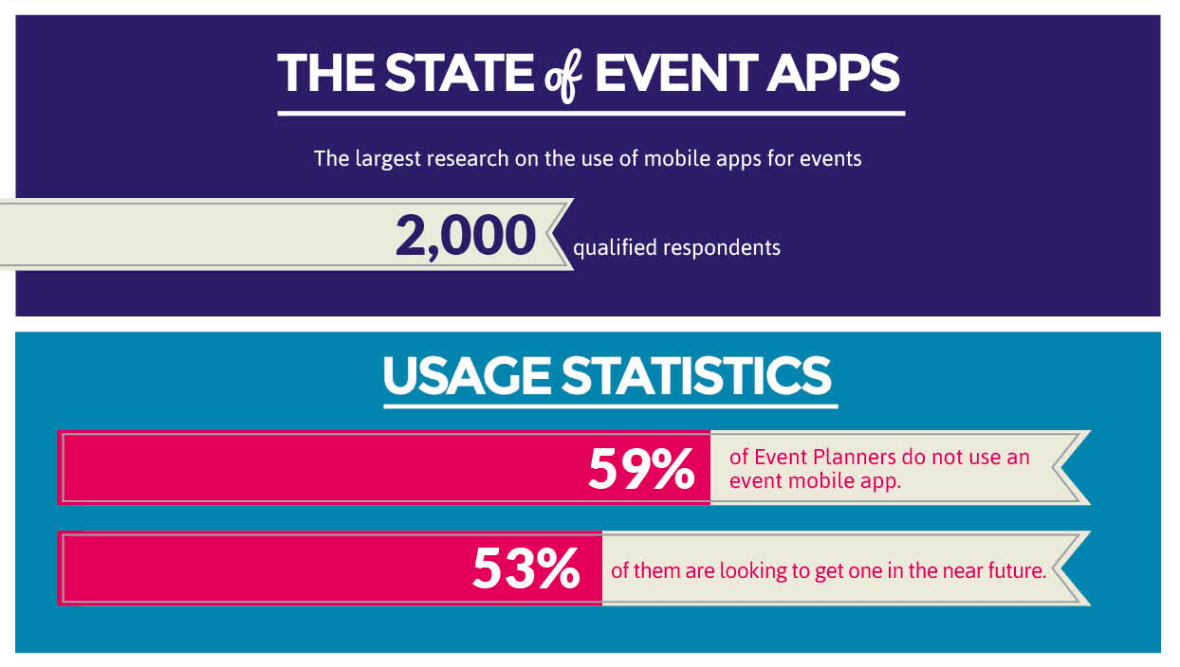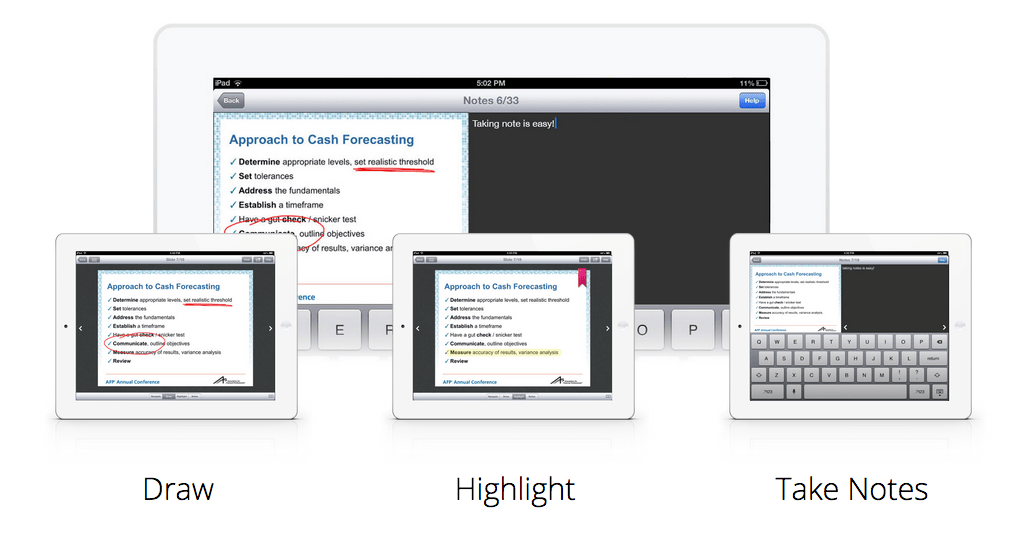No, Taking Notes Is Not Dead

How To Engage Your Millennial Attendees Without Sacrificing a Valid Educational Experience
One of the most dangerous ideas going around right now is that note-taking is unnecessary in conference sessions. Note-taking is a distraction, proponents say, and less of what the speaker is saying is retained by those who are taking notes.
This sentiment is largely a reaction to what “research” has claimed the so-called millennial generation wants. Younger crowds don’t care about taking notes. With their short attention spans, they just want to be entertained.
The solution? Make sessions more like entertainment and less like a learning environment! As someone who falls into this generational age bracket, I can confidently say this is a huge mistake.
Don’t get me wrong. Trying to create a fun, interactive environment is great, as long as you don’t lose focus of the fact that your goal is in fact to deliver an exceptional educational experience to your attendees.
Encouraging attendees NOT to take notes because it doesn’t seem inline with active participation is harmful to the whole conference ecosystem. Just take a look at these stats:

Source: “Building and Bettering Your Castle of Chaos”, Ann Bynum, AAPD 2014 Annual Conference
At the beginning of her session, “Building and Bettering Your Castle of Chaos,” at AAPD’s annual conference, Ann Bynum asked her audience to listen, take notes, and get actively involved. She claims doing all these will increase retention up to 90%, which is reinforced by the advice given on Dartmouth’s Academic Skills Center webpage.
Whoa! Now that’s impressive.
And even the New York Times values note-taking so much that they had their in-house engineers design and build a table that takes notes for meeting attendees.
Let’s Not Get Ahead of Ourselves
Ann’s claim that listening, note-taking, and interaction can result in up to 90% retention isn’t as impressive as it first seems. Michael Oman-Reagan reminds us in an article entitled, “Your Nostalgia Isn’t Helping Me Learn,” that note-taking (and education in general) is not all about memorization. He says the following about students in a university classroom, though the same is true for conference attendees:
The study cited in the Vox article said that laptop use “results in shallower processing.” This might be true for some students in the short term, but what about those students who use the technology as part of a deeper process of learning over the course of a class, or a college career, or a lifetime? What about students who refer back to these notes again and again – who draw from them years later because it only takes a few clicks or keystrokes or a keyword search to pull them up? To me, deep learning is integrating the record of your thinking and education into your life for the long term.
This is inline with Continuous Education practices, which work to foster an environment of collective and collaborative learning.
But Michael also touches on another important topic. That technology is crucial to the success of lifelong learners because it helps them organize and reference notes they’ve taken over the years. In fact, his entire argument is a refreshing counterpoint to those who claim paper and pen trumps digital note-taking.

Source: Course Hero
Given that only 10% of a session may be retained by a student or attendee, these notes are meant to provide a future reference point. They are a symbolic bookmark that helps the mind recall the information it’s searching for.
About a third of the way through the article, Michael makes another important observation. He says that the many popular articles out there claiming pen and paper is superior to digital note-taking are actually exposing a problem with the way learners are taking notes.
Digital note-taking technology is still relatively new (especially in comparison to pen and paper) and so learners aren’t accustomed to best practices yet. Because of this, students and attendees may misuse the technology. Instead of taking notes, they may surf the web, connect with friends on social media, or play games.
This however is not their fault according to Michael. Instead, lecturers have failed to hold their audiences’ attention and have not provided enough value for them to stay engaged.
What he’s suggesting doesn’t fall into the same vein as replacing education with entertainment. It’s an observation that much of the information presented in these scenarios is communicated in a dull or stale way, or that the information itself is rehashed and of no true value to the learners.
What Does Taking Notes Have to Do With Active Engagement?
Note-taking may seem like a passive learning experience at first glance. Heads down, silent, just listening. But writing is an active experience. Minds are working, fingers moving. And note-takers aren’t just writing down everything you’re saying. They’re making micro connections to other things they’ve learned or past experiences they’ve had that resonate with what they’re hearing.
Younger learners are just as curious and knowledge-driven as previous generations. Just because there may have been a shift in values doesn’t mean there’s a decrease in work ethic or interest (or even attention).
What, then, do your younger attendees need from you to get the most out of your conference?
Engaging, Informative Speakers
This should be a given, but it’s obviously one of the primary reasons attendees aren’t paying attention.
The professor who bans technology because he fears that his students will browse Facebook during class is backwards. His audience is paying to listen to his lecture, yet he is not engaging enough to hold their attention.
The same is true for a speaker who can’t inspire attendees to write down what he’s saying.
It’s a speakers’ job to get her audience talking to one another and asking questions. It’s also a speakers’ job to provide her audience with valuable information that they’ll be able to bring back to the office, business meeting, or everyday life.
If students aren’t taking notes or writing down quotes, it’s because the presentation doesn’t have useful or interesting material.
Your job as an event planner is to do your research and make sure your speakers will interact with and engage your attendees while delivering useful content. A good speaker is both and educator and an entertainer. Ask them what they know about these two sides of speaking before you book them.
Encourage Attendees to Take Different Types of Notes
Remind your attendees regularly that they’re at your conference to have fun, to make new connections, and to learn.
Send out an email with a list of best practices regarding note-taking.
It may sound silly, but giving your attendees the proper skills they need to have a successful experience at your conference is your job. Let them know that there are a variety of note-taking techniques and that they should work to find the one that’s right for their individual needs.
Encourage your attendees to type or write their notes if they’re textual learners. If they’re visual learners, drawing diagrams, highlighting PowerPoint slides, and making marks on handouts might be their best bet. Auditory learners would do best to record the sessions they attend and play them back later (while in the car during their commute or through hosting a lunch and learn with colleagues back at the office).
Kinesthetic learners need a little help from your speakers. It’s their job to get the audience moving, talking to one another, and asking questions.
Also remind your speakers that everyone learns differently and ask them to accommodate every learning style. Strong, simple visuals that they back up with great spoken examples (both through stories and data) are the best way to include everyone.
Also, don’t forget that sharing quotes or engaging in conversation via social platforms is a form of note-taking itself. Grabbing a valuable insight from a speaker and posting it to Twitter will both increase retention and foster engagement. Encourage this behavior and set up the proper platforms (hashtags, groups, etc.) so your younger attendees can use these to interact with your conference’s educational content the way that comes natural to them.
Give Attendees the Tools They Need to Succeed
I disagree with Michael Oman-Reagan on one point in particular. It’s not always a boring presenter that drives a learner to social media.
Technology is built to be distracting. We’re constantly getting notifications and pop-ups. The physical world is a big place as it is. The size of our current digital world is immeasurable and everything there is vying for our attention.
Michael does make a good point when he says we should be using that digital world to further engage audiences. But my favorite aspect of both a conference and a classroom is that they’re part of a world of their own. They’re gated environments that have rules unto themselves, like little micro-societies. They’re safe places for like-minded people to interact in.
For this, I disagree that those distractions are acceptable. What’s missing, however, is a digital environment to compliment the culture that the classroom, college, or conference creates.

Source: Event Manager Blog
Luckily event apps are becoming quite popular. For the past three years Julius Solaris of Event Manager Blog has released a comprehensive report on event apps called the Event App Bible. This year’s research revealed that while 59% of event planners currently are not using an event app, 53% are looking to get one in the near future.
The benefits of an event app solve some of the crucial issues above. They provide attendees with the opportunity to network with other attendees through a gated social network, share insights they’ve picked up from the conference over the greater social web directly through the app, and take a variety of note types (such as traditional text, drawing, and highlighting) directly on speakers’ presentation slides.

Source: eventScribe
The greatest asset these offer is a focused environment relevant to the conference without all the distractions of the wide world web.
Sending attendees home with proceedings of your conference is also an overlooked value-add.
If the goal of education is to provide learners with a frame of reference in the future, audio paired with visuals of the handouts and slides is perhaps one of the most valuable records possible. This is the reason webinars have become a huge hit over the years.
Attendees will be able to cross reference their personal notes with what was actually said and seen. This, over time, will dramatically increase retention and the ability to use the information critically.
The beauty of technology is that through things like event apps and proceedings websites, event organizers can create a platform for their attendees. Attendees will have access to all the content from the events they attend in one organized and easy-to-search database.
And all this comes natural to your younger attendees. They are tech savvy and expect digital environments that will compliment they’re experiences. If you don’t provide a platform for them to interact with your content and each other, they’ll likely fall into those so-called distractions and end up scrolling through their news feed on Facebook.
Note-Taking Is a Sign of Active Participation
At the end of the day, note-taking is a sign of active participation.
If you provide the proper tools and environment, attendees will WANT to write down what’s being said for their own personal benefit (to remember, to refer back to) and to share their newly acquired knowledge with others (back at the office and on social media). I’ve been in plenty of sessions where better content means more active participation which in turn leads to more people frantically writing notes and tweeting.
Encouraging attendees to take notes is helpful but unnecessary. If you provide them with content that they want to write down, remember, and share and give them the tools to do this successfully, the note-taking process will come naturally.
Embracing new technology is a first step. Synthesizing the old way of thinking with a new way of doing is a crucial next step. The ability to translate ideas into words, use them as reference points, and share them with others is a hallmark of successful learning.
Technology may be changing, expectations may be shifting, but note-taking will still be a cornerstone of continuing education going forward no matter how many blog posts and self-proclaimed experts tell you that a note-taking attendee is not engaged.
Further Reading & Additional Resources
Articles
For Attendees
- Effective Listening and Note-taking Tips for Conference Attendees
- How to Take Effective Conference Notes
- How to Take Great Notes at a Conference
- 5 Tips for Making the Most of a Conference
For Speakers
- How to Engage Your Audience
- Seven Ways Speakers Can Enchant Their Audiences
- What Do Meeting Planners Expect and Want from Speakers?
- Before & After: 4 Slide Makeover Tips
For Event Planners
- Dear Event Planner, I hate You. Sincerely, Your Speaker
- 4 Things Meeting Planners Can Do To Keep Their Speakers Happy
- Maximize Your Conference Proceedings with These Ten Simple Tips
- 7 Ways To Engage Event Attendees
Resources
- Note Taking Templates: PDF and Word documents with templates of different note-taking systems.
- More Note Taking Templates: 40 template with note taking methods for effective learning.
- eventScribe: An attendee platform that includes an event app with note-taking features and a conference proceedings website.
- Evernote: The world’s most popular note-taking app in the cloud.